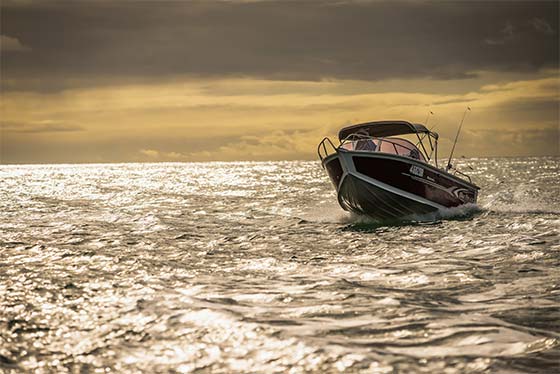Weather
Check the weather forecast and consider staying ashore if warnings are current or the weather appears doubtful. Be aware of your boat’s safe operating limits and your capabilities. For example, if you have a small vessel consider postponing the trip if the forecast winds are for 15 knots or more and seas of more than one metre. Bad weather can increase the dangers to you and your vessel. You may be swamped by waves, be blown off course or fall overboard.
Remember 'if in doubt, don't go out'.
Visit BOM to check the marine weather conditions.

Weather conditions
Before heading out make sure you check:
- Weather conditions that can impact on navigating safely such as fog, heavy rain, darkness and glare.
- Whether your comfort will be affected by extreme heat or cold.
- Wave conditions including swell and wave heights.
Be prepared for all weather conditions:
- Check in with your local Volunteer Marine Rescue before heading out.
- Lifejackets for everyone on board. It is always best to wear your lifejacket at all times.
- Pack warm clothing and wet weather gear for cooler weather.
- Sunscreen, sun protective clothing, hats, sunglasses and drinking weather for warmer weather.
- Required lights and safety equipment on board.
Winds
The table shows the wind speed of the various warnings issued by the BOM.
Average wind speed (knots)
| Strong wind warning |
25 - 33 knots 45 - 60 km per hour |
| Gale warning |
34 - 47 knots 61 - 85 km per hour |
| Storm warning | 48 knots and more Wind gusts up to 40% above the mean speed |
Squalls
- Sudden squalls are not easy to predict.
- Check the horizon for rapidly darkening and lowering clouds or whitecap waves.
- Squalls don’t usually last long and often precede a change in wind direction.
- If you get caught in a sudden squall:
- Head for the shore or the protected side of an island, if you are close.
- If not, head into the wind and waves at a steady speed.
- Don’t let the vessel drift side on to the wind and waves (it may take on water and capsize).
- Without power or anchor in use, drag a sea anchor from the bow to keep the boat pointing towards the waves (for example, a sturdy bucket or oar on a rope)
Thunderstorms
- Thunderstorms are a serious hazard for boats.
- They are indicated by heavy tall masses of clouds called cumulonimbus that produce strong, gusty winds blowing out from the storm front.
- Observe which direction the cumulonimbus cloud is moving (clouds often move in different directions from surface wind) and head for shore if it is going to pass over or within a few kilometres of you.
Waves
- Waves are a major cause of accidents and drownings, on both inland and coastal waters.
- The stronger the wind and the longer the ‘fetch’- length of water over which the wind blows, the bigger the waves.
- Waves can be influenced by local conditions, such as tides and currents.
- A forecast of ‘seas to 2 metres’ refers to the average wave height of the highest one third of waves. The largest waves may be up to twice that size.
Tides
Check the times of high and low tide before you depart - you don't want to run aground (and access to some boat ramps may be restricted at low tide).
- Current South Australian tide information is available from the Bureau of Meteorology (BOM).
- Bureau of Meteorology interactive tide predictions
- The BOM Weather app includes marine features including wind speed and direction and gust, and wave height and direction. The BOM Weather app is free and available from the Apple App Store or Google Play.
- Australian National Tide Tables is available for purchase from the Australian Hydrographic office.


